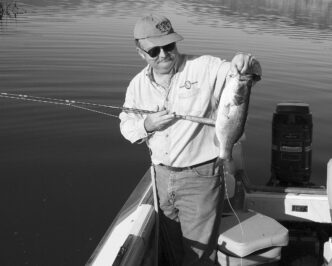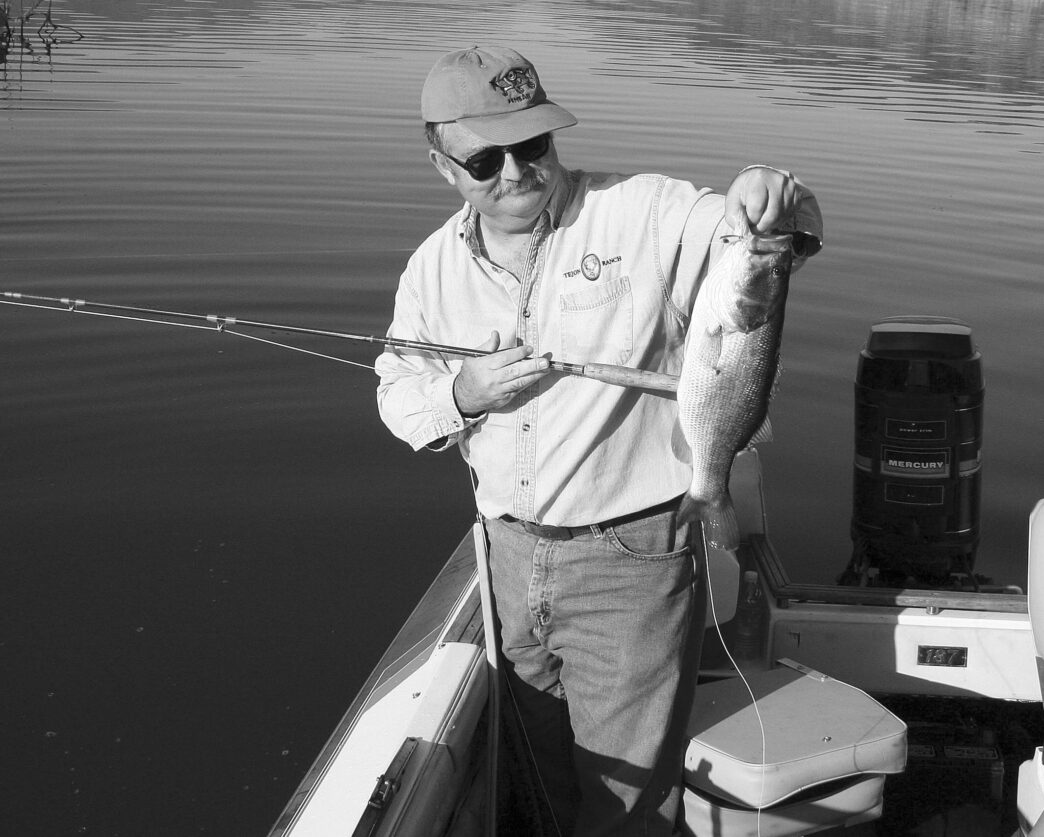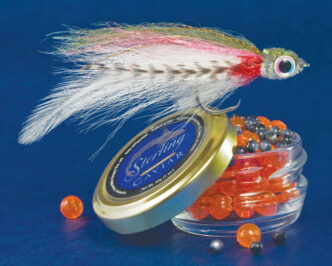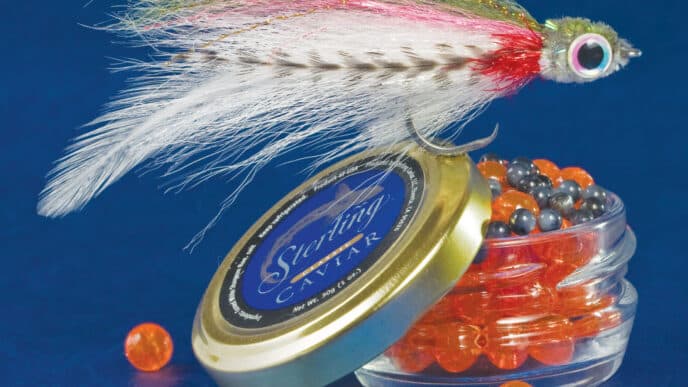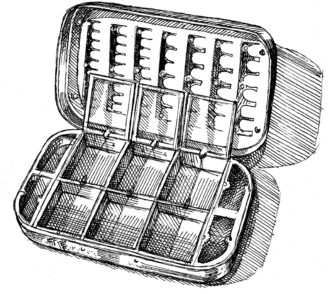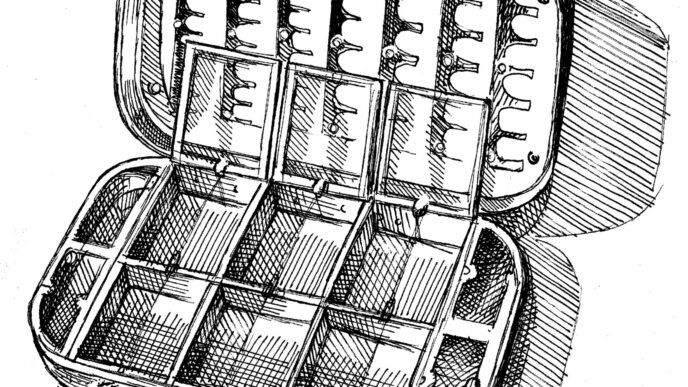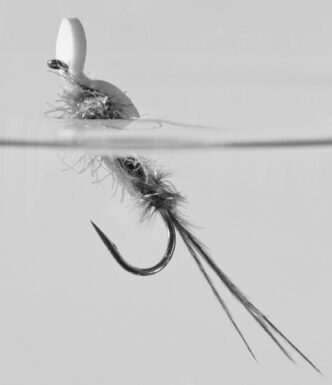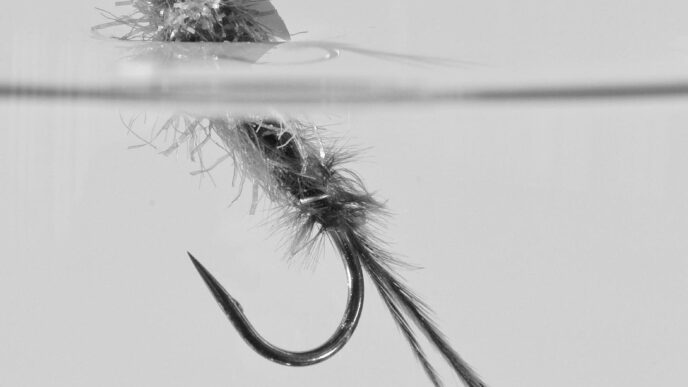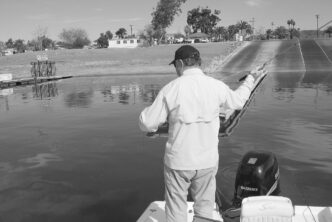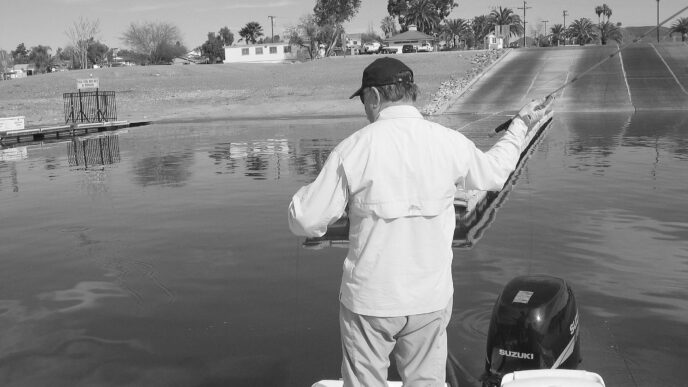I recently fished a local lake that holds a fair number of decent-sized largemouth bass. It was a quiet day, and I wasn’t entirely alone — there were a couple of boats on the lake. As I watched, one of the boaters hooked a sizeable fish, played it quickly to the side of the boat, then levered it over the gunwale with the pool-cue bass rod he was using and quickly released the fish after removing the hook. These actions took just a few seconds, and the fellow handled the fish with deft hands and more than a little respect. The bass went back into its lake little worse for being caught.
It would be fun to be able to do that with a fly rod, but levering any big fish with the long, whippy rods we use is asking for a broken rod tip. You simply can’t lift a bass over the gunwale of even a low-profile bass boat with a fly rod the way you can with a stout bait-casting rod and expect the rod to survive.
Those of us who insist on pursuing black bass with the long rod and flies need to adopt a different approach to the way we land and release our fish. An ordinary largemouth isn’t going to cause you all that much trouble — no more than the average trout. It’s different when you have to take into account where you catch the fish, as well as the fighting ability of the fish itself. Bass like to live where there is overhead cover and in and around solid objects that seem to reach out and catch any line you throw in their direction. I used to fish a small pond on a naval base that I could visit once or twice a year with a fellow who had worked there as a security guard. We’d take our float tubes and spend a few hours casting to bass that saw a fly or lure only once in a blue moon.
The distinguishing features of this pond were the ring of palm trees that surrounded it and the extensive weed beds that grew nearly continuously around the shore. It was a bit of a struggle to get your tube through the weeds and into the clear water in the deeper center of the little lake, but once you did, there were a couple of things you could count on. One was the ever-present palm fronds that fell from the trees and floated on top of the weeds, which made good overhead cover for the bass. The other was that you would also invariably end up retrieving one of these fronds with each bass you caught. It’s hard enough to wrestle a largemouth weighing two or three pounds out of a weed bed with another two or three pounds of salad attached, but adding six feet of palm frond makes the task almost impossible.
Even worse was a particular spot where I almost invariably caught a big bass. Somebody had thrown an old aluminum lawn chair into the pond, and it sank into the weeds, creating a bit of an opening. There was always at least one bass lurking under or around that old lawn chair, and a well-placed bug tossed over the top of the chair generated an almost immediate strike. The problem was retrieving the bass without bringing the lawn chair along for the ride.
Someone eventually became fed up, pulled the chair out of the hole, and tossed it up onto the bank. For weeks afterward, nobody caught anything from that particular spot, and finally someone else stuck the chair back into the the weed bed, where it promptly became a hot target again.
You need a rod with a fair amount of backbone to fish in these conditions. Lately, it has become fashionable to pursue largemouths with rods as light as a 6-weight. It is true that a modern 6-weight will cast most, if not all of the basic bass flies and bugs and that in open water, you can battle even a very large fish to submission with a well-handled 6-weight rod. I have done it more than once.
On the other hand, retrieving a three-pound bass that’s dragging four or five pounds of weed sometimes puts a heck of a strain on a light rod. I’ve seen a few rods broken doing this kind of “slop” fishing, and in general, I think that a 7-weight or 8-weight rod may be more of what you need when the going gets tough.
I’ve expressed a fondness for fishing fiberglass rods before, and their ability to stand up to punishment is one of the reasons why I continue to like these rods for much of my bass angling. They also have a slower, more forgiving action when casting large, wind-resistant flies.
An old glass rod will give you as good a performance when casting big bugs as a graphite rod, and it will take a lot of abuse. That’s not to say that graphite rods are fragile, but they do have a habit of taking stress right up to a certain point and then suddenly letting go.
Once you have the bass you caught close to the boat, then the question becomes how you handle it. You see a lot of differing ideas about how one should handle — or not handle — a trout. Lately, it has become popular when fishing with barbless flies to use your hemostats or a pair of needle-nose pliers to release the fish with a quick flip of the fly and never touch it at all.
Some anglers are strong advocates of this style of releasing their trout, and I have no doubt it does prevent some injuries to the fish. On the other hand, I was raised with the idea that if you are careful and keep your hands wet, you can manipulate a trout without fatally injuring it.
With bass, it’s even easier to do keep from injuring a fish. For one thing, bass are, by and large, a much hardier species than trout. They live in a world of solid objects that they constantly rub against while going about their daily routine, and many of the foods they consume have spines or claws and resist being eaten with considerable vigor. And not only are bass a tougher fish, they have a built-in handle.
If you’ve fished for bass at all, you must know that their big mouth provides a convenient place to grasp the fish without grabbing any other part of the body. Bass have teeth, but these teeth are tiny in comparison with the size of the mouth, and the worst that can happen to you from holding a bass by its lower lip is a slightly roughened thumb from a whole day of handling bass, if you are lucky enough to catch a bunch of them.
The greatest danger you face from grasping a bass by its lower lip is coming in contact with the hook you just stuck into the fish’s face. Unless the fish is large and starts twisting around in an effort to get free of your grip, you aren’t in much danger — certainly nothing like the peril of sticking your fingers in a bass’s mouth after it has hit a big lure with two or three large treble hooks hanging from it. Most veteran bass anglers have been hooked more than once by a quick twitch of a big bass driving hooks into their hand. Of course, the bass faces some danger, too. Holding a bass by the lower lip is convenient for the angler, but can be hard on a really large fish. The sheer weight of a big largemouth can overstress the jaw and cause injury.
I prefer to hold a lipped bass as vertically as possible. I see guys on the TV fishing programs trying to hold a bass horizontally by twisting the fish into a more or less horizontal position, and I suspect that doing so can cause considerable damage, not only to the mouth of a bass, but to its internal organs, as well.
If you have to or want to hold a bass in a horizontal position, do it by grasping the lower lip lightly and supporting the weight of the fish with your other hand under the fish’s belly. Any bass that weighs more than a couple of pounds will benefit from this treatment.
I also try to keep my fingers out of the gill flaps. The gills on a bass of any size are very close to the edge of the gill flap, and it doesn’t take a lot of touching to damage a bass’s gills. Bass will bleed freely from the gills because of the big blood vessels there that pick up oxygen from the water.
You will want to avoid the dorsal fin. Like other sunfishes, bass have sharp spines in the top fin, and you can get poked rather painfully. These fins aren’t as large or as sharp in comparison with body size as they are on bluegills, but you can still get stuck if you don’t handle a bass with a little care.
There’s another issue in the handling of bass where I depart a bit from the conventional wisdom. When I am fishing from a bass boat that has live wells, I seldom put a bass in one. Yes, I know these wells can keep bass healthy, provided they have been properly cleaned and maintained, but I don’t personally agree with the idea of catching a bass and releasing it later in another part of a lake.
This is especially true when spring fishing for bass at or near breeding and egg-laying time. If you catch a bass off of a nest and don’t return it almost immediately, the eggs, which are the next generation of bass, won’t survive. I prefer to catch and release the majority of the bass I fish for, and I like to return a bass to the same spot where I caught it.
Another thing I like to stress is not holding a bass of any size out of the water for several minutes while taking pictures. As already noted, bass are hardy fish, but it is wise to keep them out of the water for only brief periods of time. If you handle your bass right, they will be there.



